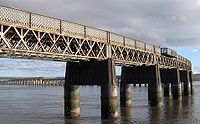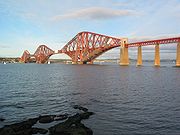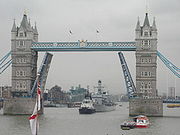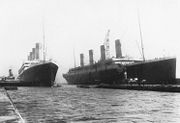
William Arrol
Encyclopedia
Sir William Arrol was a Scottish
civil engineer
, bridge
builder, and Liberal Party
politician.
The son of a spinner, he was born in Houston, Renfrewshire
, and started work in a cotton
mill
at only 9 years of age. He started training as a blacksmith
by age 13, and went on to learn mechanics
and hydraulics
at night school. In 1863 he joined a company of bridge manufacturers in Glasgow
, but by 1872 he had established his own business, the Dalmarnock Iron Works, in the east end of the city. In the late 1870s he went on to found Sir William Arrol & Co.
, a leading international civil engineering
business.
 In 1878, he secured the contract for the Caledonian Railway
In 1878, he secured the contract for the Caledonian Railway
Bridge over the Clyde
, and in 1882 he was awarded the reconstruction contract for the Tay Rail Bridge
, which had collapsed in 1879. His company went on to construct the Forth Bridge
which was completed in 1890. At the time, the Tay and Forth bridges were the largest of their type in the world. They were notable not just for their size but also the use of steel
in the Forth bridge, and the riveting method developed by Arrol to attach the girders to one another.
 The bridge is, even today, regarded as an engineering
The bridge is, even today, regarded as an engineering
marvel. It is 2.5 km (1.6 mi) in length, and the double track is elevated 46 m (approx. 150 ft) above high tide. It consists of three main spans of 1710 ft (521.2 m), two side spans of 675 ft, 15 approach spans of 168 ft (51.2 m), and five of 25 ft (7.6 m). Each main span comprises two 680 ft (207.3 m) cantilever
arms supporting a central 350 ft (106.7 m) span girder bridge. The three great four-tower cantilever structures are 340 ft (104 m) tall, each 70 ft (21.3 m) diameter foot resting on a separate foundation. The southern group of foundations had to be constructed as caissons
under compressed air, to a depth of 90 ft (27.4 m). At its peak, approximately 4,600 workers were employed in its construction. Initially, it was recorded that 57 lives were lost; however, after extensive research by local historians, the figure has been revised upwards to 98.
Both bridges are known for their high safety factors, a natural result of the under-design of the first Tay bridge by Thomas Bouch
, and both bridges have recently (2008) been renovated.
 Other notable bridges followed, including: Tower Bridge
Other notable bridges followed, including: Tower Bridge
in London
, completed in 1894. Construction started in 1886 and took eight years with five major contractors Sir John Jackson
(foundations), Baron Armstrong
(hydraulics), William Webster
, Sir H.H. Bartlett
, and Sir William Arrol & Co.
. It employed 432 construction workers. E W Crutwell was the resident engineer for the construction. Two massive piers, containing over 70,000 tons of concrete
, were sunk into the river bed to support the construction. Over 11,000 tons of steel
provided the framework for the towers and walkways. This was then clad in Cornish
granite
and Portland stone
, both to protect the underlying steelwork and to give the bridge a pleasing appearance.
, the Hawkesbury Bridge in Australia
and the Keadby Bridge
in Lincolnshire
.
The extant but at-risk Warrington Transporter Bridge
is also an Arrol construction.
 His company, Sir William Arrol & Co.
His company, Sir William Arrol & Co.
, was contracted by Harland and Wolff
Shipyard, Belfast
, to construct a large gantry (known as the Arrol Gantry) for the construction of three new super-liners, one of which was called the RMS Titanic. Like the ships themselves, the gantry crane
was one of the largest built at the time, comparing with transporter bridge
s in length, height and capability.
in 1890, and elected as the Liberal Member of Parliament
(MP) for South Ayrshire
at the 1895 general election
, serving the constituency until 1906. He served as President of The Institution of Engineers and Shipbuilders in Scotland
from 1895–1897.
He spent the latter years of his life on his estate at Seafield, near Ayr
, where he died on 20 February 1913.
His company, Sir William Arrol & Co.
, continued in business after his death until 1969 when it was acquired by Clarke Chapman
.
Scotland
Scotland is a country that is part of the United Kingdom. Occupying the northern third of the island of Great Britain, it shares a border with England to the south and is bounded by the North Sea to the east, the Atlantic Ocean to the north and west, and the North Channel and Irish Sea to the...
civil engineer
Civil engineer
A civil engineer is a person who practices civil engineering; the application of planning, designing, constructing, maintaining, and operating infrastructures while protecting the public and environmental health, as well as improving existing infrastructures that have been neglected.Originally, a...
, bridge
Bridge
A bridge is a structure built to span physical obstacles such as a body of water, valley, or road, for the purpose of providing passage over the obstacle...
builder, and Liberal Party
Liberal Party (UK)
The Liberal Party was one of the two major political parties of the United Kingdom during the 19th and early 20th centuries. It was a third party of negligible importance throughout the latter half of the 20th Century, before merging with the Social Democratic Party in 1988 to form the present day...
politician.
The son of a spinner, he was born in Houston, Renfrewshire
Renfrewshire
Renfrewshire is one of 32 council areas used for local government in Scotland. Located in the west central Lowlands, it is one of three council areas contained within the boundaries of the historic county of Renfrewshire, the others being Inverclyde to the west and East Renfrewshire to the east...
, and started work in a cotton
Cotton
Cotton is a soft, fluffy staple fiber that grows in a boll, or protective capsule, around the seeds of cotton plants of the genus Gossypium. The fiber is almost pure cellulose. The botanical purpose of cotton fiber is to aid in seed dispersal....
mill
Factory
A factory or manufacturing plant is an industrial building where laborers manufacture goods or supervise machines processing one product into another. Most modern factories have large warehouses or warehouse-like facilities that contain heavy equipment used for assembly line production...
at only 9 years of age. He started training as a blacksmith
Blacksmith
A blacksmith is a person who creates objects from wrought iron or steel by forging the metal; that is, by using tools to hammer, bend, and cut...
by age 13, and went on to learn mechanics
Mechanics
Mechanics is the branch of physics concerned with the behavior of physical bodies when subjected to forces or displacements, and the subsequent effects of the bodies on their environment....
and hydraulics
Hydraulics
Hydraulics is a topic in applied science and engineering dealing with the mechanical properties of liquids. Fluid mechanics provides the theoretical foundation for hydraulics, which focuses on the engineering uses of fluid properties. In fluid power, hydraulics is used for the generation, control,...
at night school. In 1863 he joined a company of bridge manufacturers in Glasgow
Glasgow
Glasgow is the largest city in Scotland and third most populous in the United Kingdom. The city is situated on the River Clyde in the country's west central lowlands...
, but by 1872 he had established his own business, the Dalmarnock Iron Works, in the east end of the city. In the late 1870s he went on to found Sir William Arrol & Co.
Sir William Arrol & Co.
Sir William Arrol & Co. was a leading Scottish civil engineering business founded by William Arrol and based in Glasgow. It built some of the most famous bridges in the United Kingdom including the Forth Bridge and Tower Bridge in London.-Early history:...
, a leading international civil engineering
Civil engineering
Civil engineering is a professional engineering discipline that deals with the design, construction, and maintenance of the physical and naturally built environment, including works like roads, bridges, canals, dams, and buildings...
business.
Tay Bridge

Caledonian Railway
The Caledonian Railway was a major Scottish railway company. It was formed in the early 19th century and it was absorbed almost a century later into the London, Midland and Scottish Railway, in the 1923 railway grouping, by means of the Railways Act 1921...
Bridge over the Clyde
River Clyde
The River Clyde is a major river in Scotland. It is the ninth longest river in the United Kingdom, and the third longest in Scotland. Flowing through the major city of Glasgow, it was an important river for shipbuilding and trade in the British Empire....
, and in 1882 he was awarded the reconstruction contract for the Tay Rail Bridge
Tay Rail Bridge
The Tay Bridge is a railway bridge approximately two and a quarter miles long that spans the Firth of Tay in Scotland, between the city of Dundee and the suburb of Wormit in Fife ....
, which had collapsed in 1879. His company went on to construct the Forth Bridge
Forth Bridge (railway)
The Forth Bridge is a cantilever railway bridge over the Firth of Forth in the east of Scotland, to the east of the Forth Road Bridge, and 14 kilometres west of central Edinburgh. It was opened on 4 March 1890, and spans a total length of...
which was completed in 1890. At the time, the Tay and Forth bridges were the largest of their type in the world. They were notable not just for their size but also the use of steel
Steel
Steel is an alloy that consists mostly of iron and has a carbon content between 0.2% and 2.1% by weight, depending on the grade. Carbon is the most common alloying material for iron, but various other alloying elements are used, such as manganese, chromium, vanadium, and tungsten...
in the Forth bridge, and the riveting method developed by Arrol to attach the girders to one another.
Forth Bridge

Engineering
Engineering is the discipline, art, skill and profession of acquiring and applying scientific, mathematical, economic, social, and practical knowledge, in order to design and build structures, machines, devices, systems, materials and processes that safely realize improvements to the lives of...
marvel. It is 2.5 km (1.6 mi) in length, and the double track is elevated 46 m (approx. 150 ft) above high tide. It consists of three main spans of 1710 ft (521.2 m), two side spans of 675 ft, 15 approach spans of 168 ft (51.2 m), and five of 25 ft (7.6 m). Each main span comprises two 680 ft (207.3 m) cantilever
Cantilever
A cantilever is a beam anchored at only one end. The beam carries the load to the support where it is resisted by moment and shear stress. Cantilever construction allows for overhanging structures without external bracing. Cantilevers can also be constructed with trusses or slabs.This is in...
arms supporting a central 350 ft (106.7 m) span girder bridge. The three great four-tower cantilever structures are 340 ft (104 m) tall, each 70 ft (21.3 m) diameter foot resting on a separate foundation. The southern group of foundations had to be constructed as caissons
Caisson (engineering)
In geotechnical engineering, a caisson is a retaining, watertight structure used, for example, to work on the foundations of a bridge pier, for the construction of a concrete dam, or for the repair of ships. These are constructed such that the water can be pumped out, keeping the working...
under compressed air, to a depth of 90 ft (27.4 m). At its peak, approximately 4,600 workers were employed in its construction. Initially, it was recorded that 57 lives were lost; however, after extensive research by local historians, the figure has been revised upwards to 98.
Both bridges are known for their high safety factors, a natural result of the under-design of the first Tay bridge by Thomas Bouch
Thomas Bouch
Sir Thomas Bouch was a British railway engineer in Victorian Britain.He was born in Thursby, near Carlisle, Cumberland, England and lived in Edinburgh. He helped develop the caisson and the roll-on/roll-off train ferry. He worked initially for the North British Railway and helped design parts of...
, and both bridges have recently (2008) been renovated.
Tower Bridge

Tower Bridge
Tower Bridge is a combined bascule and suspension bridge in London, England, over the River Thames. It is close to the Tower of London, from which it takes its name...
in London
London
London is the capital city of :England and the :United Kingdom, the largest metropolitan area in the United Kingdom, and the largest urban zone in the European Union by most measures. Located on the River Thames, London has been a major settlement for two millennia, its history going back to its...
, completed in 1894. Construction started in 1886 and took eight years with five major contractors Sir John Jackson
John Jackson (UK politician)
Sir John Jackson was a Unionist Member of Parliament for Devonport, from 1910–18, retiring from politics when his constituency was merged into another....
(foundations), Baron Armstrong
William George Armstrong, 1st Baron Armstrong
William George Armstrong, 1st Baron Armstrong CB, FRS was an effective Tyneside industrialist who founded the Armstrong Whitworth manufacturing empire.-Early life:...
(hydraulics), William Webster
William Webster
William Webster may refer to:* William Webster , British clergyman* William Bennett Webster , doctor, amateur geologist and political figure in Nova Scotia, Canada...
, Sir H.H. Bartlett
Herbert Henry Bartlett
Sir Herbert Henry Bartlett, 1st Baronet was a civil engineer and contractor responsible for many landmark buildings in London. Born at Hardington Mandeville, he was chairman and managing director of Perry & Co., with which he was associated with for 59 years...
, and Sir William Arrol & Co.
Sir William Arrol & Co.
Sir William Arrol & Co. was a leading Scottish civil engineering business founded by William Arrol and based in Glasgow. It built some of the most famous bridges in the United Kingdom including the Forth Bridge and Tower Bridge in London.-Early history:...
. It employed 432 construction workers. E W Crutwell was the resident engineer for the construction. Two massive piers, containing over 70,000 tons of concrete
Concrete
Concrete is a composite construction material, composed of cement and other cementitious materials such as fly ash and slag cement, aggregate , water and chemical admixtures.The word concrete comes from the Latin word...
, were sunk into the river bed to support the construction. Over 11,000 tons of steel
Steel
Steel is an alloy that consists mostly of iron and has a carbon content between 0.2% and 2.1% by weight, depending on the grade. Carbon is the most common alloying material for iron, but various other alloying elements are used, such as manganese, chromium, vanadium, and tungsten...
provided the framework for the towers and walkways. This was then clad in Cornish
Cornwall
Cornwall is a unitary authority and ceremonial county of England, within the United Kingdom. It is bordered to the north and west by the Celtic Sea, to the south by the English Channel, and to the east by the county of Devon, over the River Tamar. Cornwall has a population of , and covers an area of...
granite
Granite
Granite is a common and widely occurring type of intrusive, felsic, igneous rock. Granite usually has a medium- to coarse-grained texture. Occasionally some individual crystals are larger than the groundmass, in which case the texture is known as porphyritic. A granitic rock with a porphyritic...
and Portland stone
Portland stone
Portland stone is a limestone from the Tithonian stage of the Jurassic period quarried on the Isle of Portland, Dorset. The quarries consist of beds of white-grey limestone separated by chert beds. It has been used extensively as a building stone throughout the British Isles, notably in major...
, both to protect the underlying steelwork and to give the bridge a pleasing appearance.
Other bridges
Arrol also built the Nile Bridge in EgyptEgypt
Egypt , officially the Arab Republic of Egypt, Arabic: , is a country mainly in North Africa, with the Sinai Peninsula forming a land bridge in Southwest Asia. Egypt is thus a transcontinental country, and a major power in Africa, the Mediterranean Basin, the Middle East and the Muslim world...
, the Hawkesbury Bridge in Australia
Australia
Australia , officially the Commonwealth of Australia, is a country in the Southern Hemisphere comprising the mainland of the Australian continent, the island of Tasmania, and numerous smaller islands in the Indian and Pacific Oceans. It is the world's sixth-largest country by total area...
and the Keadby Bridge
Keadby Bridge
Keadby Bridge, more formally known as the King George V Bridge, crosses the River Trent near Althorpe and Keadby in Lincolnshire.-History:...
in Lincolnshire
Lincolnshire
Lincolnshire is a county in the east of England. It borders Norfolk to the south east, Cambridgeshire to the south, Rutland to the south west, Leicestershire and Nottinghamshire to the west, South Yorkshire to the north west, and the East Riding of Yorkshire to the north. It also borders...
.
The extant but at-risk Warrington Transporter Bridge
Warrington Transporter Bridge
The Warrington Transporter Bridge across the River Mersey is a structural steel transporter bridge with a span of 200 feet. It is 30 feet wide, and 76 feet above high water level, with an overall length of 339 feet...
is also an Arrol construction.
Arrol Gantry

Sir William Arrol & Co.
Sir William Arrol & Co. was a leading Scottish civil engineering business founded by William Arrol and based in Glasgow. It built some of the most famous bridges in the United Kingdom including the Forth Bridge and Tower Bridge in London.-Early history:...
, was contracted by Harland and Wolff
Harland and Wolff
Harland and Wolff Heavy Industries is a Northern Irish heavy industrial company, specialising in shipbuilding and offshore construction, located in Belfast, Northern Ireland....
Shipyard, Belfast
Belfast
Belfast is the capital of and largest city in Northern Ireland. By population, it is the 14th biggest city in the United Kingdom and second biggest on the island of Ireland . It is the seat of the devolved government and legislative Northern Ireland Assembly...
, to construct a large gantry (known as the Arrol Gantry) for the construction of three new super-liners, one of which was called the RMS Titanic. Like the ships themselves, the gantry crane
Gantry crane
Gantry cranes, bridge cranes, and overhead cranes, are all types of cranes which lift objects by a hoist which is fitted in a hoist trolley and can move horizontally on a rail or pair of rails fitted under a beam...
was one of the largest built at the time, comparing with transporter bridge
Transporter bridge
A transporter bridge is a type of movable bridge that carries a segment of roadway across a river. The gondola is slung from a tall span by wires or a metal frame. The design has been used to cross navigable rivers or other bodies of water, where there is a requirement for ship traffic to be...
s in length, height and capability.
Career
Arrol was knightedKnight Bachelor
The rank of Knight Bachelor is a part of the British honours system. It is the most basic rank of a man who has been knighted by the monarch but not as a member of one of the organised Orders of Chivalry...
in 1890, and elected as the Liberal Member of Parliament
Member of Parliament
A Member of Parliament is a representative of the voters to a :parliament. In many countries with bicameral parliaments, the term applies specifically to members of the lower house, as upper houses often have a different title, such as senate, and thus also have different titles for its members,...
(MP) for South Ayrshire
South Ayrshire (UK Parliament constituency)
South Ayrshire was a county constituency of the House of Commons of the Parliament of the United Kingdom from 1868 until 1983, when it was abolished...
at the 1895 general election
United Kingdom general election, 1895
The United Kingdom general election of 1895 was held from 13 July - 7 August 1895. It was won by the Conservatives led by Lord Salisbury who formed an alliance with the Liberal Unionist Party and had a large majority over the Liberals, led by Lord Rosebery...
, serving the constituency until 1906. He served as President of The Institution of Engineers and Shipbuilders in Scotland
Institution of Engineers and Shipbuilders in Scotland
The Institution of Engineers and Shipbuilders in Scotland is a professional body for engineers and shipbuilders in Scotland.-Founding:The inaugural meeting of the Institution of Engineers in Scotland was held on 1 May 1857...
from 1895–1897.
He spent the latter years of his life on his estate at Seafield, near Ayr
Ayr
Ayr is a town and port situated on the Firth of Clyde in south-west Scotland. With a population of around 46,000, Ayr is the largest settlement in Ayrshire, of which it is the county town, and has held royal burgh status since 1205...
, where he died on 20 February 1913.
His company, Sir William Arrol & Co.
Sir William Arrol & Co.
Sir William Arrol & Co. was a leading Scottish civil engineering business founded by William Arrol and based in Glasgow. It built some of the most famous bridges in the United Kingdom including the Forth Bridge and Tower Bridge in London.-Early history:...
, continued in business after his death until 1969 when it was acquired by Clarke Chapman
Clarke Chapman
Clarke Chapman is a British engineering firm based in Gateshead, which was formerly listed on the London Stock Exchange.-History:The company was founded in 1864 in Gateshead by William Clarke...
.
External links
- NZ Craneships Hikitia and Rapaki Steam floating-crane, rated lift 80 tons, built 1926 by Sir Wm Arrol & Co.
- Climbing the Greenock Titan crane
- William Arrol on The Gazeteer for Scotland
- NZR Cranes Arrol gantry

